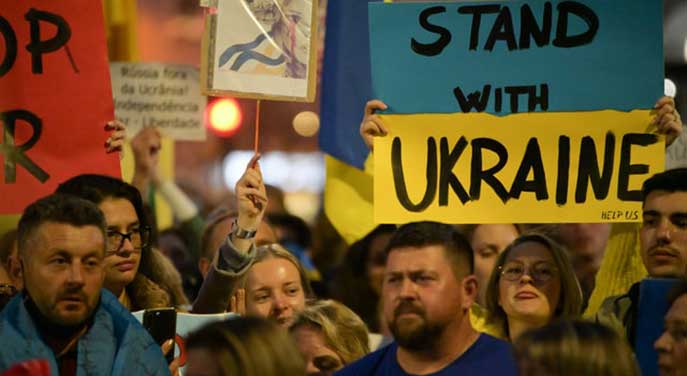 Let’s make a stipulation up front: Russian President Vladimir Putin’s invasion of Ukraine is unjustified. There’s no ambiguity on that score. Russia is the bad actor in this situation.
Let’s make a stipulation up front: Russian President Vladimir Putin’s invasion of Ukraine is unjustified. There’s no ambiguity on that score. Russia is the bad actor in this situation.
Still, it’s always useful to understand the other guy. Understanding doesn’t imply approval and insight is never a bad thing to have.
Putin is typically described as an ex-KGB operative who wants to recreate the Soviet Union. But perhaps his framework is much older.
Historian Niall Ferguson suspects Putin’s role model is Peter the Great (1672-1725), the man who ushered Russia onto the European stage as a major power. And as Ferguson reminds us, the location of one of Peter’s most famous victories – the 1709 Battle of Poltava – is in Ukraine, about 340 km east of Kyiv.
Consider Putin’s emotionally-charged March 18, 2014, speech to the Russian parliament – the one in which he defended the absorption of Crimea. Rather than stoking nostalgia for the Bolshevik Revolution, the speech evoked a sense of pride in an older Russia.
Putin’s historical rendering began with a reference to the late 10th-century baptism of Prince Vladimir at Khersones, the ancient city located on the outskirts of Sevastopol in Crimea. As ruler of Kievan Rus – the purported historical antecedent of modern Russia, Belarus and Ukraine – Vladimir was a major figure. In the late 980s, he swept his subjects into the Christian world.
Historically, though, Putin didn’t restrict himself to medieval times. Coming closer to current day, he struck more recent chords. Sevastopol was name-checked as the historic 18th-century birthplace of Russia’s Black Sea Fleet. There were also references to battles from 19th- and 20th-century wars.
And in language few Western leaders would be comfortable deploying about their own histories, there was this: “The graves of Russian soldiers whose bravery brought Crimea into the Russian empire are also in Crimea.”
Interestingly, there were no paeans to the Bolshevik era.
As Putin told the story, “After the revolution, the Bolsheviks, for a number of reasons – may God judge them – added large sections of the historical south of Russia to the Republic of Ukraine. This was done with no consideration for the ethnic makeup of the population, and today these areas form the southeast of Ukraine.”
Then came Nikita Khrushchev’s 1954 decision regarding Crimea. Speaking of its transfer to Ukraine, Putin didn’t mince words. The action was “in clear violation of constitutional norms,” and “in a totalitarian state nobody bothered to ask the citizens of Crimea and Sevastopol.”
The voice Putin adopted long predates the Soviet era. It expresses the vision of a Russia that reaches back over 1,000 years, a Russia that was an empire and proud of it. Although it’s a perspective foreign to 21st-century Western sensibility, that doesn’t mean it lacks resonance for others.
Ukraine tragedy exposes some harsh global realities by Pat Murphy
Among them, the unintended consequences of naive policy decisions
Overall, the Soviet Union’s collapse was a benign event that produced positive results for many previously repressed societies. Unfortunately, however, it wound up leaving a Russia that’s undemocratic, aggrieved and paranoid. Isolated from Europe’s security architecture, it sits seething.
Could this have been avoided?
Putin’s vision of historic Russia notwithstanding, there’s no reasonable – or semi-reasonable – way to accommodate its full sweep. Whether Ukrainians were a distinct nation 1,000 years ago is immaterial. They are now, for the simple reason that they believe they are. And as demonstrated by their valiant resistance, they’re prepared to fight and die for it.
A recent essay by journalist Tom McTague put it neatly: “All nations are, in effect, made up, requiring somewhat mythical narratives. But just because nations are imagined does not make them fake.”
To be sure, this can create messy situations where different perceptions of nationhood collide. And perhaps one lesson to be drawn is that when empires dissolve, greater care should be taken with establishing the boundaries of the nation-states that succeed them. That way, future flashpoints might be avoided.
Crimea after the Soviet collapse is one prospective example. And following the post-First World War carve-up of the Austro-Hungarian Empire, Sudetenland is another.
Then there’s the matter of NATO’s eastward expansion. For completely understandable reasons, it was highly desired by the new member states. But it’s a large stone in Putin’s shoe.
And as much as we loathe him, we should remember that his view isn’t unique. For instance, Mikhail Gorbachev – the reforming Russian lionized by so many in the West – also strongly opposed NATO expansion. He felt “swindled” by it.
It’s a hot mess without an obvious solution. And it could get much worse.
Troy Media columnist Pat Murphy casts a history buff’s eye at the goings-on in our world. Never cynical – well, perhaps a little bit. For interview requests, click here.
The opinions expressed by our columnists and contributors are theirs alone and do not inherently or expressly reflect the views of our publication.
© Troy Media
Troy Media is an editorial content provider to media outlets and its own hosted community news outlets across Canada.


A welcome and well-researched development of your previous article on the subject, Pat. Bail o Dhia ar an obair! Mary
A welcome and well-researched development of your previous article on the subject, Pat. Bail o Dhia ar an obair! Mary